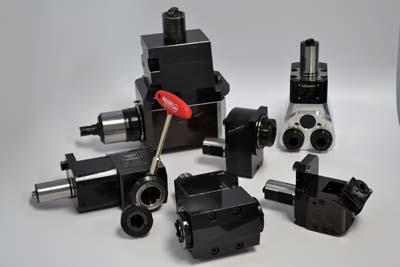
Lyndex-Nikken Inc. offers live tools for CNC lathes from Mimatic Tool Systems, with an initial focus on Mazak lathes. Designed and manufactured to Mazak specifications in Germany, Mimatic live tools enhance the performance of CNC lathes, according to the company. Mimatic live tool housings are machined from solid blocks of a special steel to achieve tight tolerances. Hardened and ground gears, precision ground spindle bearings and high performance seals result in high accuracy, rigidity, stability and durability in turning operations.
Currently, Lyndex-Nikken's Mimatic live tool line accommodates Mazak QTNexus QTS, SQT, Hyper Quadrex Series, Multiplex and Cyberturn machines. Mimatic static tooling is also available from Lyndex-Nikken for these Mazak models. All of these holders are available with Mimatic mi, a one-hand-operated modular quick-change system, to allow the user to preset tools and reduce machining downtime. Custom-made live tools can be engineered for specific applications. In the future, Lyndex-Nikken plans to carry additional Mimatic tooling for other leading builders.
Along with live tools for Mazak lathes, Lyndex-Nikken stocks a range of standardized live tools for Okuma, Mori Seiki, Nakamura-Tome, and other major builders, including those that utilize Sauter turrets. Lyndex-Nikken's live tool offering includes high-speed tooling, coolant feed thru tools, high pressure thru coolant, axial tools, radial tools, dual output radial tools and universal tools. Straight and offset units, modular quick-change systems and tapping quick-change holders are also available. Many models are lightweight and compact. In addition to Mimatic live tooling, Lyndex-Nikken carries a range of precision Mimatic Angle Heads for machining centers.
"Mimatic and Lyndex-Nikken share a commitment to providing quality products that maximize the capabilities of machine tools," stated Scott Irie, regional sales manager, Lyndex-Nikken. That is not all the companies share. Mimatic has recently moved its North American office to Mundelein, and is now located within Lyndex-Nikken's Illinois facility. "Working in close proximity will enable our companies to exchange and develop ideas that further advance the performance of machining centers and lathes," commented Irie.
Contact Details
Related Glossary Terms
- centers
centers
Cone-shaped pins that support a workpiece by one or two ends during machining. The centers fit into holes drilled in the workpiece ends. Centers that turn with the workpiece are called “live” centers; those that do not are called “dead” centers.
- computer numerical control ( CNC)
computer numerical control ( CNC)
Microprocessor-based controller dedicated to a machine tool that permits the creation or modification of parts. Programmed numerical control activates the machine’s servos and spindle drives and controls the various machining operations. See DNC, direct numerical control; NC, numerical control.
- coolant
coolant
Fluid that reduces temperature buildup at the tool/workpiece interface during machining. Normally takes the form of a liquid such as soluble or chemical mixtures (semisynthetic, synthetic) but can be pressurized air or other gas. Because of water’s ability to absorb great quantities of heat, it is widely used as a coolant and vehicle for various cutting compounds, with the water-to-compound ratio varying with the machining task. See cutting fluid; semisynthetic cutting fluid; soluble-oil cutting fluid; synthetic cutting fluid.
- feed
feed
Rate of change of position of the tool as a whole, relative to the workpiece while cutting.
- tapping
tapping
Machining operation in which a tap, with teeth on its periphery, cuts internal threads in a predrilled hole having a smaller diameter than the tap diameter. Threads are formed by a combined rotary and axial-relative motion between tap and workpiece. See tap.
- turning
turning
Workpiece is held in a chuck, mounted on a face plate or secured between centers and rotated while a cutting tool, normally a single-point tool, is fed into it along its periphery or across its end or face. Takes the form of straight turning (cutting along the periphery of the workpiece); taper turning (creating a taper); step turning (turning different-size diameters on the same work); chamfering (beveling an edge or shoulder); facing (cutting on an end); turning threads (usually external but can be internal); roughing (high-volume metal removal); and finishing (final light cuts). Performed on lathes, turning centers, chucking machines, automatic screw machines and similar machines.







